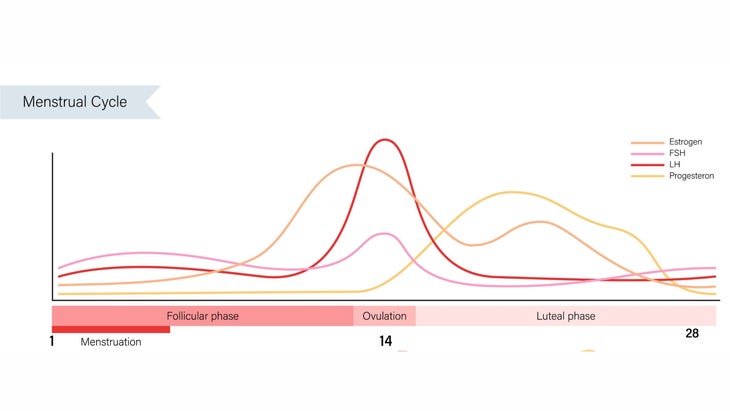When Laura Philipp won the 2024 Ironman World Championship, one of the first things she talked about in her post-race speech was period tracking.
“For this race, a lot of things were actually coming together,” she said in her finish-line interview after the win. “So for example, I was in the first half of my menstrual cycle, and I always told myself, once this happens on a world championship race day, this is the chance. I feel so much stronger than in the second [half].”
It’s not the first time Philipp called out her menstrual cycle as a factor in her triathlon success. After setting an Ironman record of 8:18:20 at Hamburg in 2022, Philipp told Triathlete period tracking was a “game changer” in optimizing her training and nutrition.
Does this mean all triathletes with a period should track their menstrual cycles with the same attention to detail as power meter data, nutritional intake, and sleep? Could period tracking really help athletes crack the code for a PR?
If you spend any time on social media, you probably assume the answer is “yes.” Women’s health and performance – specifically, as it pertains to hormones, is a hot topic right now. There’s no shortage of influencers and self-proclaimed experts offering advice on how to use period tracking to optimize athletic performance, but actual credentialed experts proffering detailed advice and protocols? Those are harder to come by. That’s because the science of period tracking for athletic performance is in its infancy, says Dr. Kelly McNulty, sports physiology researcher at Northumbria University and founder of Period of the Period.
It’s great that we’ve had this boom in menstrual cycle tracking,” says McNulty. “Menstrual cycle tracking is more common now, and it’s advocated for, especially within elite environments, as something athletes should be doing. There’s a tendency that everyone’s a female health expert now, but on the flip side of that, the science isn’t quite there yet. We don’t want to be giving bad advice off low-quality research.”
That’s not to say period tracking is a bad idea – only that athletes should beware of one-size-fits-all advice on how women perform during certain phases of the cycle. Let’s take a deeper look at how to make period tracking work for you, whether you’re just starting out in triathlon or an Ironman World Champion.
What the science says about period tracking for athletes
As Triathlete has written about before, physiological research on female athletes has been limited in comparison to male athletes. The major contributing factor to this dearth of information is a belief that it’s simply “too complicated” to study women – their monthly menstrual cycle and resulting hormonal fluctuations skew otherwise straightforward results. The lack of research on this topic means data collected on males is extrapolated to females, and female athletes usually train based on recommendations made for male athletes.
McNulty was part of a 2021 research team that reviewed more than 5,000 studies across six popular sport and exercise journals, finding that women accounted for only 34% of total participants, with as few as 6% of studies focusing exclusively on females. McNulty later found that even fewer studies looked at women by life stage – a particularly “invisible” cohort is women going through midlife, perimenopause, and menopause. Simply put, the science on women isn’t that great, and though it is an area of increasing interest for researchers, McNulty says it will still be five to 10 years before there’s a robust body of high-quality research.
Still, McNulty warns, “Everybody’s an expert now. And so everyone’s coming out saying that they will tailor your training plan to your menstrual cycle, and it sounds too good to be true in a lot of ways. We don’t want to come in and tell people, ‘No, this is a bad idea,’ but we do feel really strongly about making sure that people know that if you’re paying for someone to do that, and they’re claiming they’re an expert, that nobody’s really fully an expert on that, except for the people who are currently doing the research – and even they don’t have all the answers.”
There are, of course, some already-published studies that indicate hormone fluctuations aren’t a complication; they’re actually key to understanding and optimizing athletic performance in women. Hormones like estrogen and progesterone rise and fall throughout a woman’s month-long menstrual cycle, influencing everything from how she performs in training or racing to how she recovers. Some studies have found hormones may affect ligament laxity, suggesting injury risk may increase at various stages of the cycle. There is also evidence that when hormones fluctuate, so too does a woman’s body’s ability to maintain proper hydration levels, metabolize nutrients, and regulate body temperature – unique factors critical to female athletic performance.
Should you avoid period-tracking apps for athletes?
These studies, plus a growing demand for women-specific health advice, have led to an influx of period-tracking apps for athletes, which help women monitor where they are in their monthly cycles. Some apps even recommend what kind of training to do (or avoid) and when.
Though such apps can be enlightening for female athletes looking for insights on their individual physiology, McNulty and her colleagues warn that there currently isn’t enough research to make standard recommendations related to period tracking and sport performance.
That doesn’t mean that period tracking is a waste of time; only that experts aren’t at the point to confidently say “on X day of the cycle, women are best off doing Y workout and recovering with Z food.” McNulty says the information period-tracking apps give is often generic, and given the variety in menstrual cycle experiences among women, the information presented might not always be suited to the specific athlete. Some may also have privacy concerns with putting highly-sensitive health information into such apps.
While women wait for the scientific community to endorse a substantial body of evidence, there are still things athletes can do, McNulty says: ”If you are a female athlete or a coach/practitioner supporting a female athlete, then I recommend that you dive into the research and learn all you can about the potential effects hormones can have on women’s physiology. But do this with a critical eye.”
McNulty also says women can develop their own “bespoke athlete guidelines,” where each athlete uses her own expertise of her own body to identify patterns in performance. “When you learn more about your own menstrual cycle – what symptoms you experience and how you perform, train, and recover on certain days – you can use your knowledge and understanding to determine what bits of the research might apply to you and which don’t. From there you can begin to tweak and adjust things to maximize or manage performance/training depending where you are in your cycle,” she says.
It’s in these individual experiences of the menstrual cycle – not the advice of an app – where the biggest insights lie. “Every woman is different, and the research is only the beginning from which we can build our individualized content from,” McNulty says. “But this only happens if we understand our bodies first.”

How to track your period as an athlete
Tracking the menstrual cycle can be as simple as circling a day on a paper calendar or marking an X in your smartphone on the first day of your menstrual flow, or period. The menstrual cycle is counted from the first day of one period up to the first day of your next period.
The average menstrual cycle is 28 days long, but each woman is different. Some women’s periods are so regular that they can predict the day and time that the next one will start. Other women experience menstrual cycles that vary in length. Medically, periods are considered “regular” if they usually come every 24 to 38 days.
That menstrual cycle is further divided into four phases:







